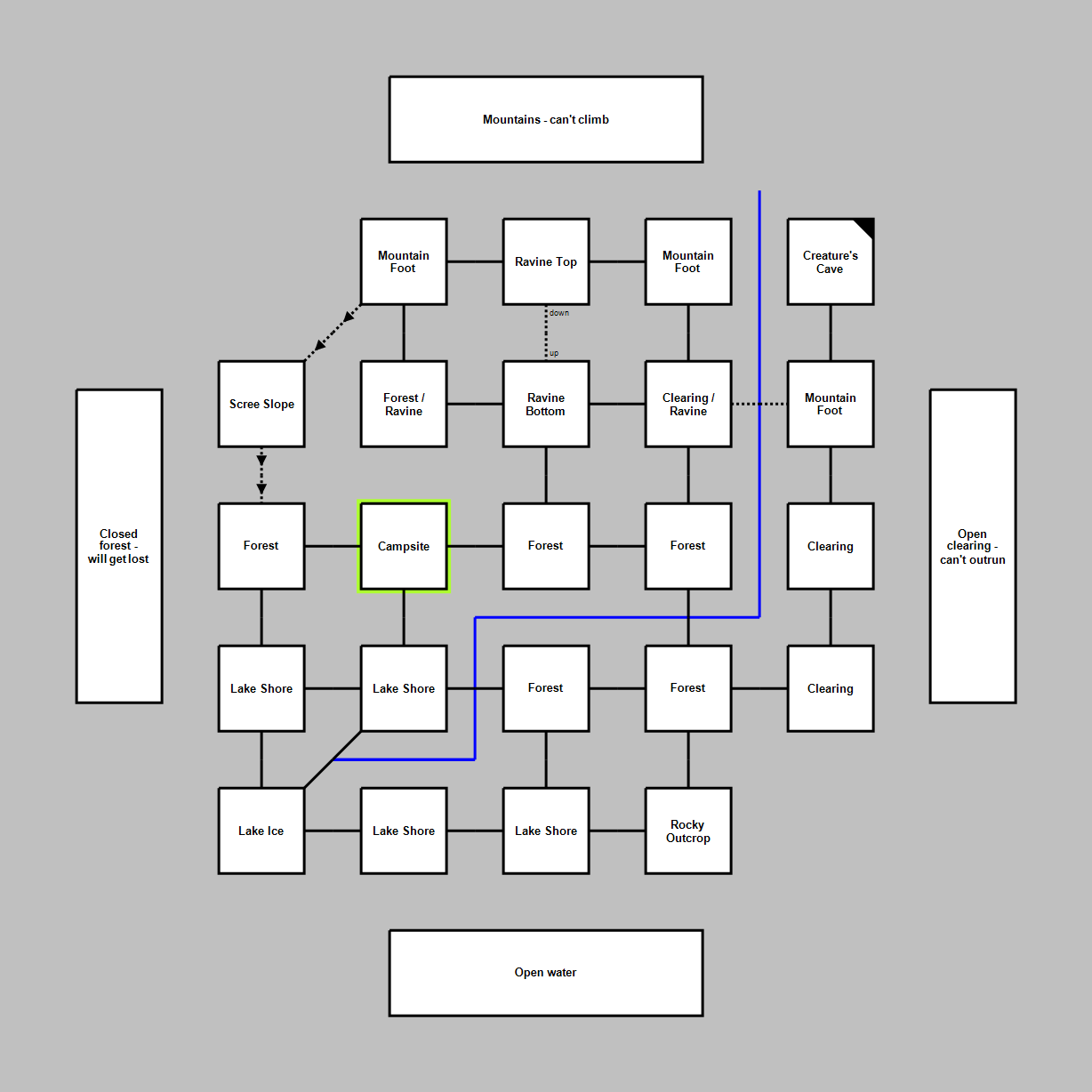Update 2 - Making a map
I've settled on the idea of the player being pursued by a monster throughout the game. I wanted to start building the game itself by creating a map which the player can be pursued around. I wanted to get this right the first time if possible, because Inform 7 is not really good for rearranging a game world once you've created it.
I had the following aims:
- Vaguely Great Lakes-y landscape (if I'm using wendigo lore as a springboard, I should at least set the game somewhere plausibly Algonquian)
- Different paths to take between areas, so that you won't be trapped in a dead end by the monster
- Relatively compact game world, to save me some work and so that the player can figure out the extent of the world quickly
- No complex exits - keep things simple with basic compass directions
This last point is maybe a little contentious. You probably don't navigate by compass directions very often - more likely, you reach places by following roads or going downhill instead of knowing you need to go east. This has been discussed a lot within interactive fiction communities (example), and there are a few games which experiment with other directions. Aaron A. Reed's Blue Lacuna, for example, has you navigate an island by landmarks, and if you want compass directions you'll have to find an actual compass within the game.
You could argue for doing something similar in my game. Perhaps the player character already knows the landscape and its landmarks, and so doesn't need a compass. It might also work for the opposite reason - if the player can't easily map the landscape by compass direction, it could cause disorientation, which seems perfect for a suspenseful game about being pursued.
But on balance, I think this might cause too much frustration for the player as well. I think this game is going to have puzzles in it, and few things are more annoying in interactive fiction than knowing you need something and not being able to find it again. It would make the game feel like a maze, and I'd rather have the player be able to move through the landscape fluidly than clumsily. (This was my experience with Blue Lacuna - although navigating by landmark works well enough, I found it difficult to grasp the actual layout of the whole island until I got the compass.)
Here's what I ended up with:

I made this map in Trizbort, a really nice mapping program for text adventures.
The basic landscape is a slope from mountains in the north through a forest towards a lake in the south. I don't want the world to feel too flat and puzzle-gamey, so hopefully this slope and the ravine towards the north of the map add some verticality. The blue line represents a river which will cut through the landscape. I've tried to border the game world by landscape features which make escaping from a monster impossible, though maybe some are more credible than others.
I've marked some rooms on the eastern side as "clearings," or places where the forest has been logged - this helps to vary the landscape and adds a possible background conflict to explore. (Perhaps the destruction of the environment for profit could tie into the wendigo-as-destructive-greed metaphor?) I also added a cave in the northeastern corner and a campsite near the centre, with the idea that the monster and player will begin the game in these places respectively.
I'm trying to think ahead to possible gameplay scenarios and puzzles. For example, dotted lines represent possible routes which the player can take but the monster cannot, so that the player has ways to throw the monster off. I broke my "no dead ends" guideline with the cave, but the dotted line path could buy the player enough time to enter the cave, do something in there, and escape.
The map mostly follows cardinal directions, with a couple of other directions here and there for variety. I'm hoping this makes the game world simple to grasp intuitively without having to make a map - for example, the player who needs to get to the lake will remember that they need to head southwest, maybe. The trade-off is that it may feel artificial as a landscape (another good argument against using compass directions in general!).
The big problem I've made for myself here is that the map is effectively 23 rooms. This is a lot of rooms to implement within a small timescale, so I may have to implement them lightly - that is, not every room will contain something interesting to look at. This is also probably the upper limit of what the player can comfortably grasp, but fitting the rooms into a 5x5 grid could help navigation.
I've already implemented this in Inform 7, but the update is too long already! Next post I make will talk about Inform 7, why it's good, and why it can be a little awkward too.

